Abstract
We report the cAMP-dependent phosphorylation of the chemotactic receptor of Dictyostelium discoideum in partially purified plasma membranes. The protein kinase responsible for receptor phosphorylation is associated with this fraction and preferentially phosphorylates the ligand-occupied form of the receptor. 8-Azido[32P]cAMP labeling of the cell surface has shown that the cAMP receptor exists in two forms. A 45-kDa protein is predominant on unstimulated cells. cAMP stimulation results in an increased receptor phosphorylation such that the receptor migrates on NaDodSO4/PAGE as a 47-kDa protein. Phosphorylation of the chemotactic receptor is not detected in membrane preparations unless cAMP is added to the incubation mixture. Only under those conditions is the phosphorylated 47-kDa form observed. The requirement for cAMP reflects the fact that the kinase involved preferentially uses the ligand-occupied receptor as a substrate. In vitro phosphorylation of the receptor does not involve tyrosine residues. The enzyme does not appear to be a cAMP- or cGMP-dependent protein kinase nor is it sensitive to guanine nucleotides, Ca2+/calmodulin, Ca2+/phospholipid, or EGTA. Similarities with the beta-adrenergic receptor protein kinase are discussed.
Full text
PDF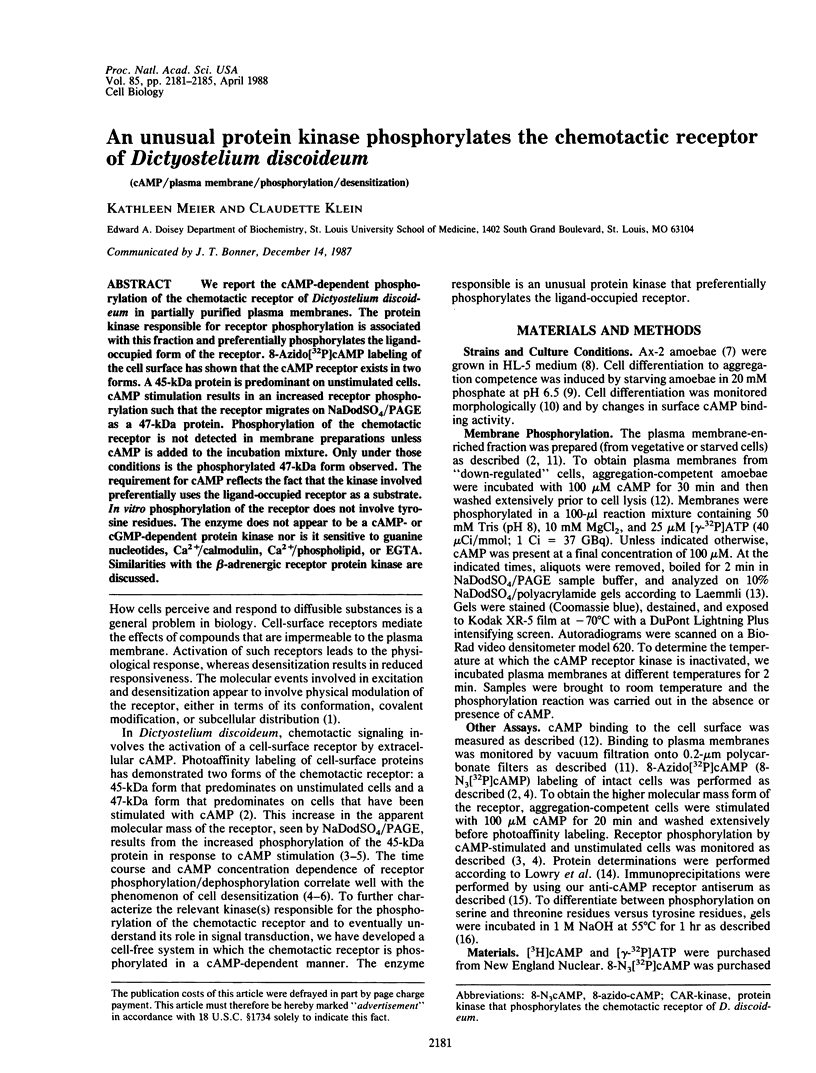
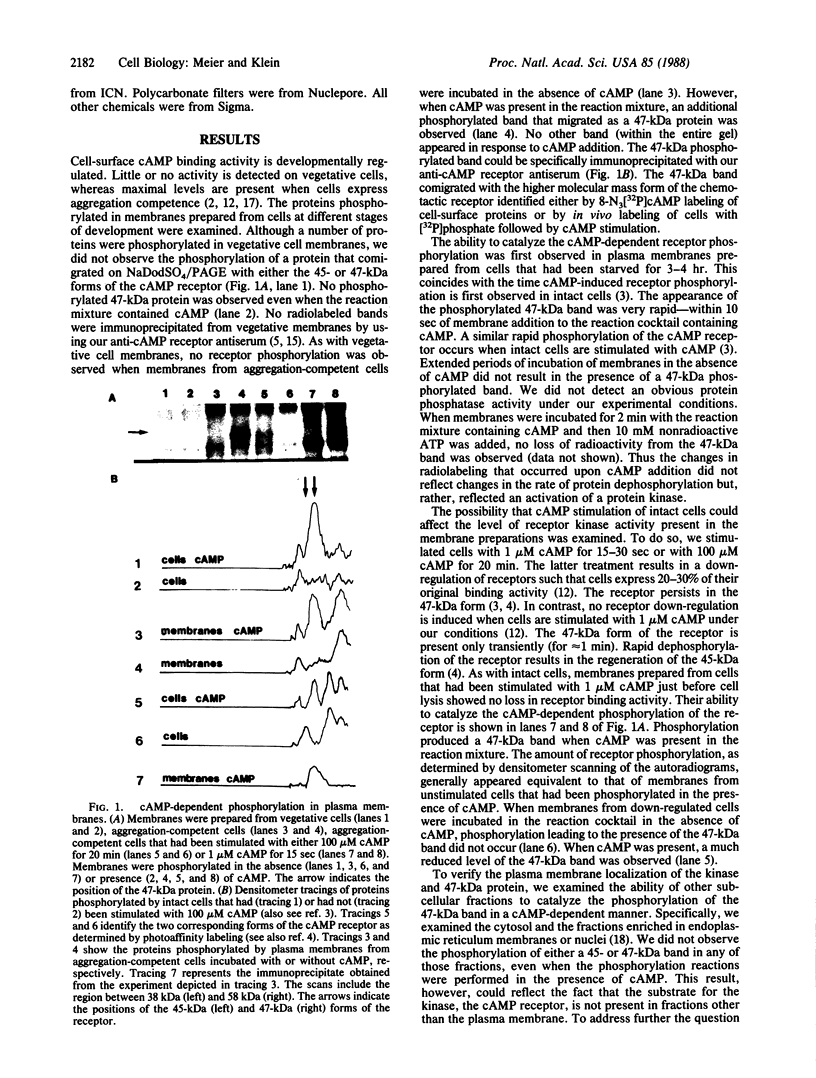
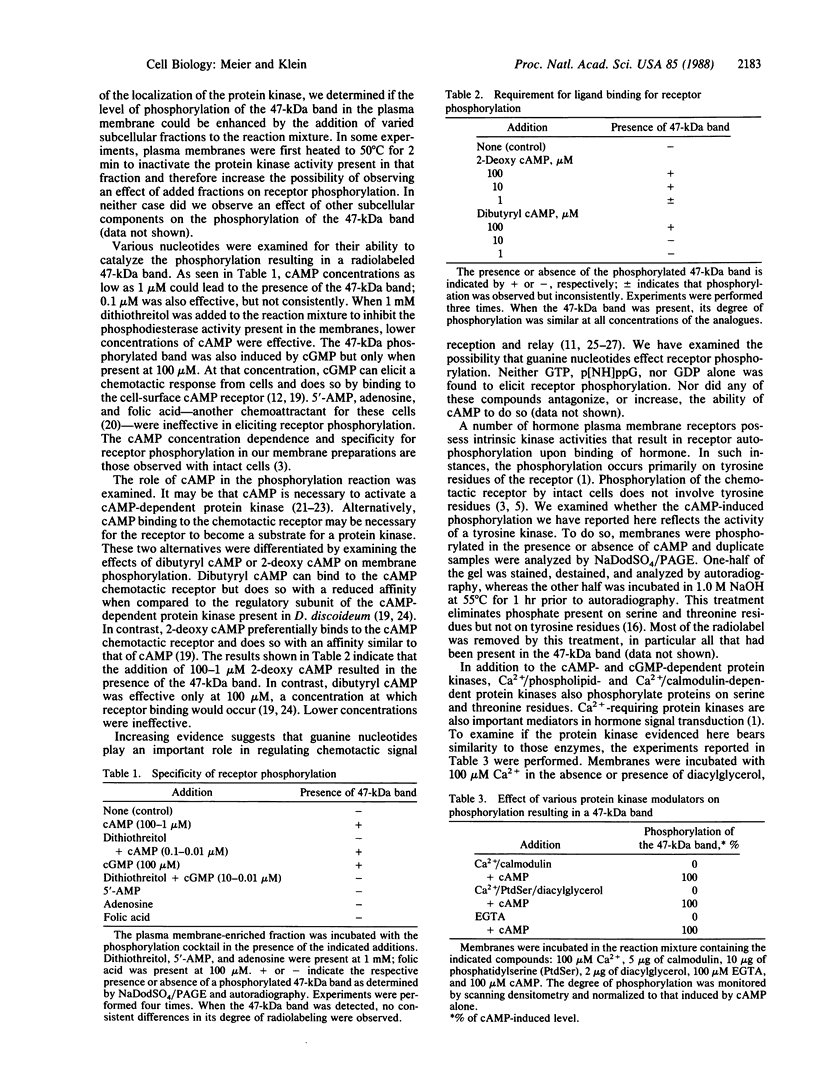
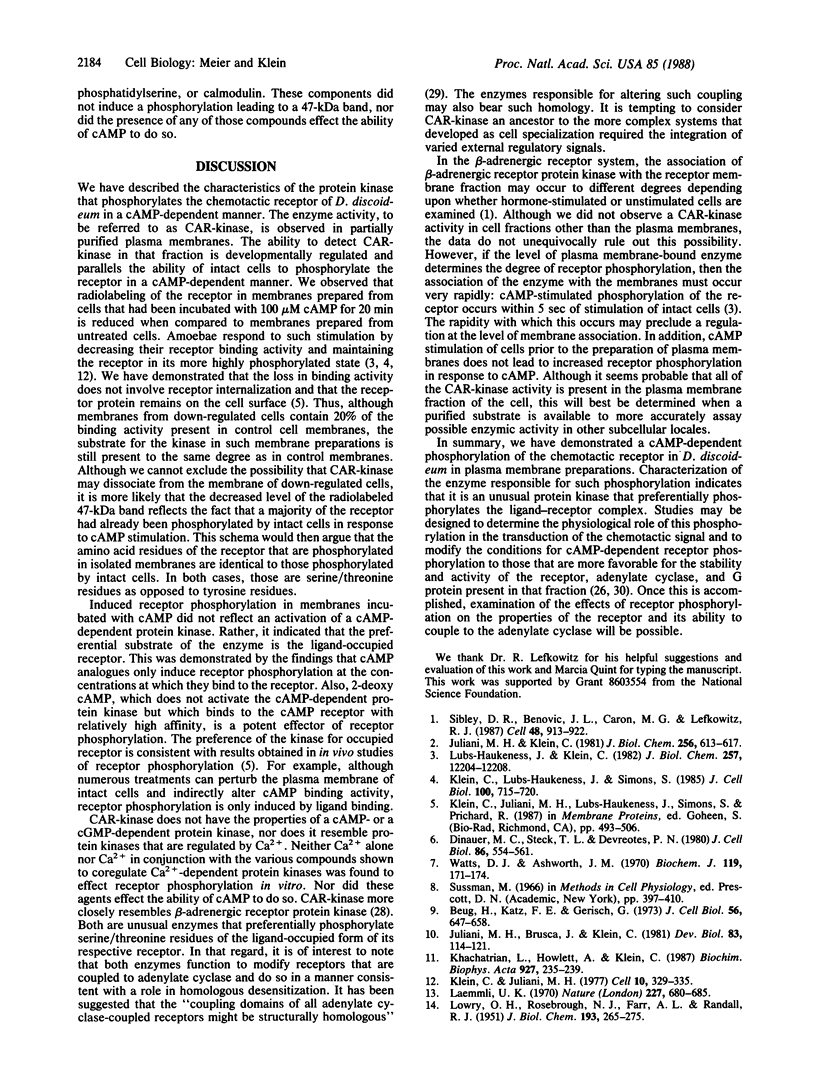
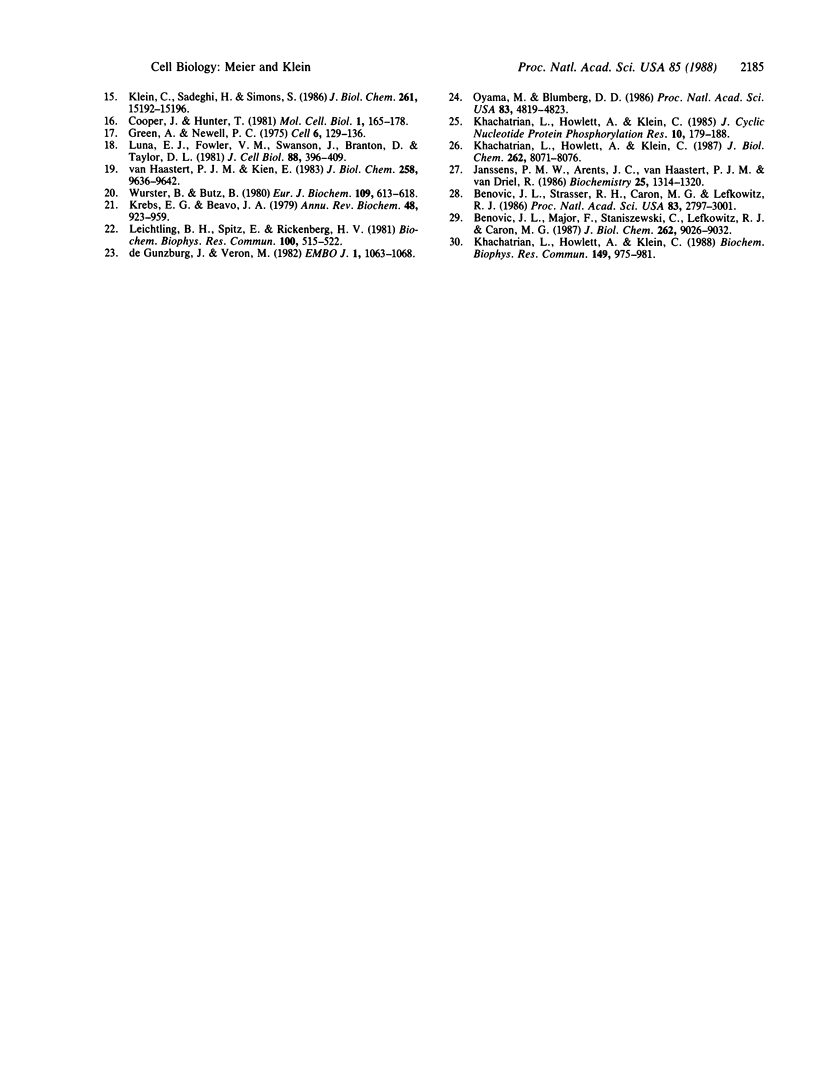
Images in this article
Selected References
These references are in PubMed. This may not be the complete list of references from this article.
- Benovic J. L., Mayor F., Jr, Staniszewski C., Lefkowitz R. J., Caron M. G. Purification and characterization of the beta-adrenergic receptor kinase. J Biol Chem. 1987 Jul 5;262(19):9026–9032. [PubMed] [Google Scholar]
- Benovic J. L., Strasser R. H., Caron M. G., Lefkowitz R. J. Beta-adrenergic receptor kinase: identification of a novel protein kinase that phosphorylates the agonist-occupied form of the receptor. Proc Natl Acad Sci U S A. 1986 May;83(9):2797–2801. doi: 10.1073/pnas.83.9.2797. [DOI] [PMC free article] [PubMed] [Google Scholar]
- Beug H., Katz F. E., Gerisch G. Dynamics of antigenic membrane sites relating to cell aggregation in Dictyostelium discoideum. J Cell Biol. 1973 Mar;56(3):647–658. doi: 10.1083/jcb.56.3.647. [DOI] [PMC free article] [PubMed] [Google Scholar]
- Cooper J. A., Hunter T. Changes in protein phosphorylation in Rous sarcoma virus-transformed chicken embryo cells. Mol Cell Biol. 1981 Feb;1(2):165–178. doi: 10.1128/mcb.1.2.165. [DOI] [PMC free article] [PubMed] [Google Scholar]
- Dinauer M. C., Steck T. L., Devreotes P. N. Cyclic 3',5'-AMP relay in Dictyostelium discoideum V. Adaptation of the cAMP signaling response during cAMP stimulation. J Cell Biol. 1980 Aug;86(2):554–561. doi: 10.1083/jcb.86.2.554. [DOI] [PMC free article] [PubMed] [Google Scholar]
- Green A. A., Newell P. C. Evidence for the existence of two types of cAMP binding sites in aggregating cells of Dictyostelium discoideum. Cell. 1975 Oct;6(2):129–136. doi: 10.1016/0092-8674(75)90003-3. [DOI] [PubMed] [Google Scholar]
- Gunzburg J., Veron M. A cAMP-dependent protein kinase is present in differentiating Dictyostelium discoideum cells. EMBO J. 1982;1(9):1063–1068. doi: 10.1002/j.1460-2075.1982.tb01297.x. [DOI] [PMC free article] [PubMed] [Google Scholar]
- Juliani M. H., Brusca J., Klein C. cAMP regulation of cell differentiation in Dictyostelium discoideum and the role of the cAMP receptor. Dev Biol. 1981 Apr 15;83(1):114–121. doi: 10.1016/s0012-1606(81)80013-9. [DOI] [PubMed] [Google Scholar]
- Juliani M. H., Klein C. Photoaffinity labeling of the cell surface adenosine 3':5'-monophosphate receptor of Dictyostelium discoideum and its modification in down-regulated cells. J Biol Chem. 1981 Jan 25;256(2):613–619. [PubMed] [Google Scholar]
- Khachatrian L., Howlett A., Klein C. Ammonium sulfate modifies adenylate cyclase and the chemotactic receptor of Dictyostelium discoideum. Evidence for a G protein effect. J Biol Chem. 1987 Jun 15;262(17):8071–8076. [PubMed] [Google Scholar]
- Khachatrian L., Howlett A., Klein C. Guanine nucleotide inhibition of adenylate cyclase in a membrane fraction from Dictyostelium discoideum. J Cyclic Nucleotide Protein Phosphor Res. 1985;10(2):179–187. [PubMed] [Google Scholar]
- Khachatrian L., Klein C., Howlett A. Pertussis and cholera toxin ADP-ribosylation in Dictyostelium discoideum membranes. Biochem Biophys Res Commun. 1987 Dec 31;149(3):975–981. doi: 10.1016/0006-291x(87)90504-3. [DOI] [PubMed] [Google Scholar]
- Khachatrian L., Klein C., Howlett A. Regulation of Dictyostelium discoideum adenylate cyclase by manganese and adenosine analogs. Biochim Biophys Acta. 1987 Feb 18;927(2):235–246. doi: 10.1016/0167-4889(87)90140-6. [DOI] [PubMed] [Google Scholar]
- Klein C., Juliani M. H. cAMP,-induced changes in cAMP-binding sites on D; discoideum amebae. Cell. 1977 Feb;10(2):329–335. doi: 10.1016/0092-8674(77)90227-6. [DOI] [PubMed] [Google Scholar]
- Klein C., Lubs-Haukeness J., Simons S. cAMP induces a rapid and reversible modification of the chemotactic receptor in Dictyostelium discoideum. J Cell Biol. 1985 Mar;100(3):715–720. doi: 10.1083/jcb.100.3.715. [DOI] [PMC free article] [PubMed] [Google Scholar]
- Krebs E. G., Beavo J. A. Phosphorylation-dephosphorylation of enzymes. Annu Rev Biochem. 1979;48:923–959. doi: 10.1146/annurev.bi.48.070179.004423. [DOI] [PubMed] [Google Scholar]
- LOWRY O. H., ROSEBROUGH N. J., FARR A. L., RANDALL R. J. Protein measurement with the Folin phenol reagent. J Biol Chem. 1951 Nov;193(1):265–275. [PubMed] [Google Scholar]
- Laemmli U. K. Cleavage of structural proteins during the assembly of the head of bacteriophage T4. Nature. 1970 Aug 15;227(5259):680–685. doi: 10.1038/227680a0. [DOI] [PubMed] [Google Scholar]
- Leichtling B. H., Spitz E., Rickenberg H. V. A cAMP-binding protein from Dictyostelium discoideum regulates mammalian protein kinase. Biochem Biophys Res Commun. 1981 May 29;100(2):515–522. doi: 10.1016/s0006-291x(81)80207-0. [DOI] [PubMed] [Google Scholar]
- Lubs-Haukeness J., Klein C. Cyclic nucleotide-dependent phosphorylation in Dictyostelium discoideum amoebae. J Biol Chem. 1982 Oct 25;257(20):12204–12208. [PubMed] [Google Scholar]
- Luna E. J., Fowler V. M., Swanson J., Branton D., Taylor D. L. A membrane cytoskeleton from Dictyostelium discoideum. I. Identification and partial characterization of an actin-binding activity. J Cell Biol. 1981 Feb;88(2):396–409. doi: 10.1083/jcb.88.2.396. [DOI] [PMC free article] [PubMed] [Google Scholar]
- Oyama M., Blumberg D. D. Interaction of cAMP with the cell-surface receptor induces cell-type-specific mRNA accumulation in Dictyostelium discoideum. Proc Natl Acad Sci U S A. 1986 Jul;83(13):4819–4823. doi: 10.1073/pnas.83.13.4819. [DOI] [PMC free article] [PubMed] [Google Scholar]
- Sibley D. R., Benovic J. L., Caron M. G., Lefkowitz R. J. Regulation of transmembrane signaling by receptor phosphorylation. Cell. 1987 Mar 27;48(6):913–922. doi: 10.1016/0092-8674(87)90700-8. [DOI] [PubMed] [Google Scholar]
- Van Haastert P. J., Kien E. Binding of cAMP derivatives to Dictyostelium discoideum cells. Activation mechanism of the cell surface cAMP receptor. J Biol Chem. 1983 Aug 25;258(16):9636–9642. [PubMed] [Google Scholar]
- Watts D. J., Ashworth J. M. Growth of myxameobae of the cellular slime mould Dictyostelium discoideum in axenic culture. Biochem J. 1970 Sep;119(2):171–174. doi: 10.1042/bj1190171. [DOI] [PMC free article] [PubMed] [Google Scholar]
- Wurster B., Butz U. Reversible binding of the chemoattractant folic acid to cells of Dictyostelium discoideum. Eur J Biochem. 1980 Aug;109(2):613–618. doi: 10.1111/j.1432-1033.1980.tb04834.x. [DOI] [PubMed] [Google Scholar]



